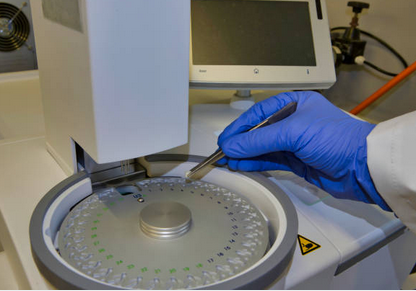Thermal Analysis
Thermal analysis is a general term defining multiple techniques used to analyse the time and temperature at which physical changes occur when a substance is heated or cooled. Each technique is defined according to the types of physical changes being analysed. When evaluating material characteristics, it is necessary to use different techniques or a combination of multiple techniques depending on the purpose.
Thermogravimetric analysis (TGA)
Thermogravimetric analysis is a method in which changes in physical and chemical properties of materials are measured as a function of increasing temperature ramp (with constant heating rate), generally extended to its decomposition temperature. The weight loss curve (TGA) and its first derivative (DTGA) is used to evaluate the weight loss of a sample.
Most of TGA curves show weight loss, which it is associated to chemical reactions (decomposition and separation of crystallization water, combustion, reduction of metallic oxides) and physical transformations (evaporation, vaporization, sublimation, desorption, drying). Exceptionally, weight gains may be observed due to reactions with gaseous components of the purge gas yielding non-volatile compounds, adsorption of gaseous products in the samples.
Our PerkinElmer Pyris 1 TGA from Perkin Elmer, which works in a temperature range from Subambient to 1000 °C with Scanning rates: 0.1°C/minute to 200°C/minute
- % Inorganic Content (including % Carbon Black and % CaCO3) by TGA (based on ISO 11358)
- Material Thermal Stability.
- Moisture and Volatiles Content.
- Composition of Multi-Component Systems.
- Shelf-Life Studies and Decomposition Kinetics.
VICAT softening point
Vicat softening point is the temperature at which a standard indenter (3 mm long, circular cross section, and area 1.000 ± 0.015 mm2) penetrates 1 mm into the surface of a plastic test specimen, that is rigid at room temperature, under definite load conditions (10 N or 50 N) and when the temperature is raised at a uniform rate (50 ºC/hour or 120 ºC/hour). The test procedure is described in ISO 306 and ASTM D1525 standards. The HDT6/VICAT instrument has six independent test stations, and works in a temperature range from room temperature to 300 °C.
Melt flow index (MFI)
Melt flow index is defined as the mass of polymer, in grams, flowing in ten minutes through a nozzle of a specific inner diameter (2.095 mm) and length (8 mm) under certain conditions of stress and temperature. The value of the melt flow index depends on the molecular structure of the polymer (molecular weight, molecular weight distribution, degree of chain branching, etc.). This value is an indirect measure of molecular weight. The melt flow index, along with the analysis of possible distortions at the extrudate will determine the processing method for the polymer. The test procedure is described in ISO 1133 standard. The CISD melt flow tester works in a temperature range from 23 to 400 °C.
Capillary Rheometry
Rheology studies the relationship between force and deformation in a material. Capillary rheometer is designed for characterizing polymer melts at high shear rates and it is the most effective instrument for measuring shear viscosity at high shear rates. The polymer melt is forced through a capillary of known dimensions. Knowing the dimensions, the flow-rate can be converted into a value for the shear rate and the pressure drop into a value for the shear stress. The true stress – true shear rate curve of the polymeric material under study can be determined. These tests are carried out outside the limits of linear viscoelastic region (LVR) and the capillary flow process resembles many industrial processes such as extrusion and injection moulding. The test procedure is described in ISO 11443 standard. The HDT6/VICAT instrument has six independent test stations, and works in a temperature range from room temperature to 300 °C.
Dynamic Rheology
Rheology studies the relationship between force and deformation in a material. Oscillatory rheometer is a versatile equipment to study polymers in the melt state. It can perform tests in oscillation, flow or creep modes. This kind of rheometer allows to work in the linear viscoelastic region (LVR) or outside the limits of LVR. In this equipment, the specimen is held between two parallel plate. The specimen is subjected to a sinusoidal torque. In the oscillation mode, the viscoelastic properties of a material are determined from the measured torque, the displacement, and the specimen dimensions. The test procedure is described in ISO 6721 standard. CISD has an oscillatory rheometer with a parallel-plate geometry from TA Instruments (model DHR-2) which works in the angular frequency range from 0 to 300 rad/s. Also, the rheometer has an environmental test chamber (ETC) accessory which employs a combination of radiant and convective heating and has a temperature range of 23 °C to 600 °C.
Dynamic Mechanical Analysis of Polymers
Dynamic Mechanical Analysis (DMA) is one of the most used tools to study the viscoelastic properties of polymers by measuring its elastic modulus and its damping after applying a sinusoidal strain over the tested specimen. Elastic modulus can be determined because of the relation between the oscillation amplitude and the applied force. Meanwhile, the damping coefficient of the polymer is determined by the gap between the force and the displacement. The variation in the viscoelastic properties of the materials with temperature allows identifying the different transitions of the material. CISD has a Dynamic Mechanical Analyzer DMA 8000 (Perkin Elmer) with working capabilities in a frequency range of 0.01 to 200 Hz and temperatures from -190 to 400 °C. • Mechanical-Thermal Properties of materials
Atomic Force Microscopy with nano Thermal Analysis
Jupiter XR Atomic Force Microscope is the first and only large-sample AFM to offer both high-speed imaging and extended range in a single scanner. Jupiter provides complete 200 mm sample access and delivers higher resolution, faster results, a simpler user experience, and the versatility to excel in both academic research and industrial R&D laboratories. Coupled with Scanning Thermal Microscopy (SThM) this is a versatile and powerful tool for the characterisation of complex multiphase materials and generates nanoscale thermal images while simultaneously obtaining contact mode images of the topography. • Higher resolution than any other large-sample AFM • Extended range 100 μm scanner is 5-20× faster than most other AFMs • From setup to results, every step is simpler and faster • Modular design adapts to your needs for maximum flexibility • Thermal analysis at nano scale
Thermal analysis by differential scanning calorimetry (DSC)
Differential scanning calorimetry is a thermo-analytical technique that measures the difference in the amount of heat required to increase the temperature of a sample and an inert reference as a function of temperature. Both the sample and the inert reference are maintained at the same temperature throughout the experiment by a controlled temperature program. This technique can be used to evaluate chemical reactions (such as thermal degradations or oxidation processes), identification of primary transitions (melting and crystallization processes), and second-order transitions such as glass transitions which can occur in the sample under certain analysis conditions.
CISD has a high sensitivity DSC 8000 equipment from Perkin Elmer which works in a temperature range from -180 to 750 °C.
Identification of glass transition temperature, crystalline melting temperature and crystallisation temperature of polymer
Thermal Stability of materials (e.g. – oxidative induction time (OiT) of materials)
DSC Identification of materials by their Crystalline Melting Temperature (according to IS EN ISO 3146:2000).
Equipment
- Differential Scanning Calorimetry (DSC)
- Dynamic Rotational Shear Rheometer
- Dynisco Capillary Rheometer
- Nano Thermal Analysis Atomic Force Microscopy (AFM)
- Thermo-gravametric anlaysis (TGA)
- Dynamic Mechanical Thermal analysis (DMTA)
- TG-IR analysis
- Vicat Softening Point and Heat Deflection Temperature (HDT)
- Melt flow Index (MFI)

If you require further advice on tensile properties testing please fill in the form below


